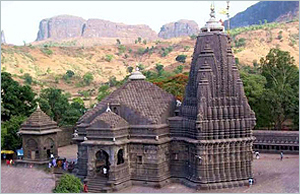 Trimbakeshwar has been well-known as a very holy pilgrimage place for centuries. In the good old days, access roads were not developed to reach there. Thick jungle surroundedthis area and fear of wild animals was perpetual. However these difficulties were overpowered by the faith and holiness of this place. When transport facilities were almost not-existant, religious minded folks still walked down to this place and performed various religious rites. Pilgrims were not certain whether they would survive and go back home. So they spent days together in performing various kinds of religious rites through the Brahmin priests in Trimbakeshwar.The Brahmin Priests were experts in performing various rites and rituals. They used to be called as Kshetropadhyay. In addition to performing religious rites, they used to provide shelter and food to the pilgrims during their visits. This helped to develop relationship between the priests and pilgrims.The priests performing the rites used to ask the pilgrims about their family tree, the namesof their relatives, and their forefathers, their next generation, their address, occupation, the deity they worshipped etc. and used to keep record of this information. The pilgrims used to sign this record. The record book where this information was stored was called as “Namavali”.
Trimbakeshwar has been well-known as a very holy pilgrimage place for centuries. In the good old days, access roads were not developed to reach there. Thick jungle surroundedthis area and fear of wild animals was perpetual. However these difficulties were overpowered by the faith and holiness of this place. When transport facilities were almost not-existant, religious minded folks still walked down to this place and performed various religious rites. Pilgrims were not certain whether they would survive and go back home. So they spent days together in performing various kinds of religious rites through the Brahmin priests in Trimbakeshwar.The Brahmin Priests were experts in performing various rites and rituals. They used to be called as Kshetropadhyay. In addition to performing religious rites, they used to provide shelter and food to the pilgrims during their visits. This helped to develop relationship between the priests and pilgrims.The priests performing the rites used to ask the pilgrims about their family tree, the namesof their relatives, and their forefathers, their next generation, their address, occupation, the deity they worshipped etc. and used to keep record of this information. The pilgrims used to sign this record. The record book where this information was stored was called as “Namavali”.
Over a period, the guest pilgrims and host priests developed binding connections Anunwritten system developed eventually and the host families of priests got rights to perform rites for specific groups of guest families. This system is still prevalent. Even today, on arrival at Trimbakeshwar, pilgrim can tell his family name and then he would be guided to a particular priest, whose family has been performing rites for the pilgrim’s family and his forefathers. The host Brahmin priest is called as “Teerthopadhyay”. In fact, the system of keeping such records is common all over India. However the record books take different names in different regions. Before the invention of a writing paper, Bhoorjapatra – a leaf of a tree named Bhoorja was used for writing. Lac was used as ink and thin, hollow, wooden sticks resembling bamboo stems were used as pens to write. The paper made out of bamboo was used. This paper lasts for years. The records used to be bound in leather covers.
Namavali includes names of men in the family. Daughters names are also written down.However, after the daughters get married, as per the Hindu tradition, they adopt husband’ family name. The married daughters family names are not included in this record. Names ofthe new born babies and the daughter-in-laws in the family are recorded. Change of address, immigration to different place, change of occupation etc. are also recorded.
Of late, the number of visitors has increased incredibly. Often their visits are of few hours.So they do not insist on performing rites through their family “Teerthopadhyay”. Therefore Namavali’s significance has taken a back seat ,as far as the visitors are concerned. However this does not lessen the importance of the incredible record preserved by the Brahmin priests for years together. Maintaining Namavali used to be the life time occupation of Brahmins and it used to earn them bread and butter. This record was so valuable that money lenders used to accept them as pledge and lend money against them. The records used to be passed on to the next generation as a valuable property, with a specific mention in the will. If the priest’s family had no offspring to pass on the record to, the records used to go to the nearest family of priests and they had the responsibility to look after the family of the donor priest.
Namavali is a valuable document for historical references. Chhatrapati Shivaji Maharaj’s handwriting is preserved in the records held by his family’s Teerthopadhyay Shree Dherge Guruji. This record is presently in the custody of the Archeology Department of Government of Maharashtra. Like wise handwritings of the eminent personalities like Shrimant Peshwe, Mahatma Gandhiji, Jawaharlal Nehru, Lokmanya Tilak, Aacharya Vinobaji Bhave, Vasudev Balwant Phadke, the famous industrialist Birla, Jagatguru Shankaracharya etc. are also preserved in Namavali.Since the records were kept and preserved for over centuries, during British Raj, these records were onsidered as legal proof in disputes of family relations, heirs and property. Even today these records are held as admissible proof in such disputes.